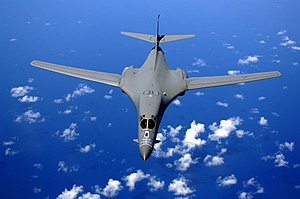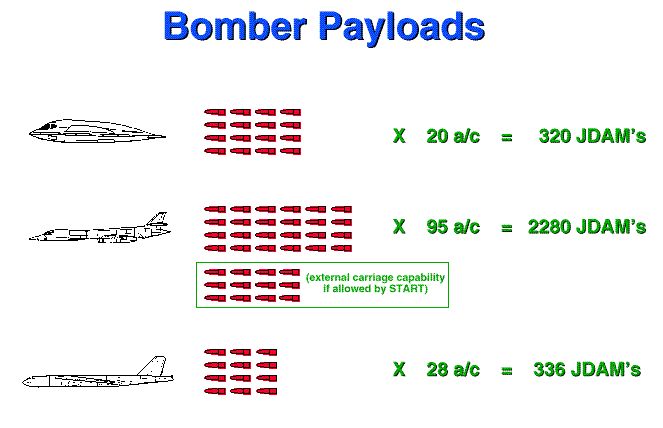Welcome to DU!
The truly grassroots left-of-center political community where regular people, not algorithms, drive the discussions and set the standards.
Join the community:
Create a free account
Support DU (and get rid of ads!):
Become a Star Member
Latest Breaking News
General Discussion
The DU Lounge
All Forums
Issue Forums
Culture Forums
Alliance Forums
Region Forums
Support Forums
Help & Search
Mechanical malfunction caused fuel leak that downed B-1B
http://www.airforcetimes.com/article/20131231/NEWS/312310012/Mechanical-malfunction-caused-fuel-leak-downed-B-1BDebris is scattered across at field after a B-1B bomber crashed Aug. 19 in a remote area near Broadus, Mont. The four crew members survived after ejecting from the aircraft.
Mechanical malfunction caused fuel leak that downed B-1B
Dec. 31, 2013 - 04:01PM
~snip~
The $318 million aircraft was destroyed when it crashed on Aug. 19 near Broadus, Mont., but all four crew members ejected safely with non-life threatening injuries, according to the report, which was released on Monday.
InfoView thread info, including edit history
TrashPut this thread in your Trash Can (My DU » Trash Can)
BookmarkAdd this thread to your Bookmarks (My DU » Bookmarks)
5 replies, 4555 views
ShareGet links to this post and/or share on social media
AlertAlert this post for a rule violation
PowersThere are no powers you can use on this post
EditCannot edit other people's posts
ReplyReply to this post
EditCannot edit other people's posts
Rec (0)
ReplyReply to this post
5 replies
 = new reply since forum marked as read
Highlight:
NoneDon't highlight anything
5 newestHighlight 5 most recent replies
= new reply since forum marked as read
Highlight:
NoneDon't highlight anything
5 newestHighlight 5 most recent replies
Mechanical malfunction caused fuel leak that downed B-1B (Original Post)
unhappycamper
Jan 2014
OP
Great info! Thanks. The B-36 should have declared obsolete on the drawing board.
Eleanors38
Jan 2014
#5
Eleanors38
(18,318 posts)1. Hasn't this plane had a history of fuel leaks?
unhappycamper
(60,364 posts)2. St. Ronnie decided to build them
http://en.wikipedia.org/wiki/B-1_Lancer

Role Supersonic Strategic bomber
National origin United States
Manufacturer North American Rockwell/Rockwell International
Boeing
First flight 23 December 1974
Introduction 1 October 1986
Status In service
Primary user United States Air Force
Produced 1973–74, 1983–88
Number built B-1A: 4
B-1B: 100
Unit cost
US$283.1 million in 1998 (B-1B)[1]
The Rockwell (now part of Boeing) B-1 Lancer[N 1] is a four-engine supersonic variable-sweep wing strategic bomber used by the United States Air Force (USAF). It was first envisioned in the 1960s as a supersonic bomber with Mach 2 speed, and sufficient range and payload to replace the Boeing B-52 Stratofortress. It was developed into the B-1B, primarily a low-level penetrator with long range and Mach 1.25 speed capability at high altitude.
Designed by Rockwell International, the bomber's development was delayed multiple times over its history, as the theory of strategic balance changed from flexible response to massive retaliation and back again. Each change in stance changed the perceived need for manned bombers. The initial B-1A version was developed in the early 1970s, but its production was canceled, and only four prototypes were built. The need for a new platform once again surfaced in the early 1980s, and the aircraft resurfaced as the B-1B version with the focus on low-level penetration bombing. However, by this point development of stealth technology was promising an aircraft of dramatically improved capability. Production went ahead as the B version would be operational before the "Advanced Technology Bomber" (which became the B-2 Spirit), during a period when the B-52 would be increasingly vulnerable. The B-1B entered service in 1986 with the USAF Strategic Air Command (SAC) as a nuclear bomber.
In the early 1990s, following the Gulf War and concurrent with the disestablishment of SAC and its reassignment to the newly formed Air Combat Command (ACC), the B-1B was converted to conventional bombing use. It first served in combat during Operation Desert Fox in 1998 and again during the NATO action in Kosovo the following year. The B-1B has supported U.S. and NATO military forces in Afghanistan and Iraq. The Lancer is the supersonic component of the USAF's long-range bomber force, along with the subsonic B-52 and Northrop Grumman B-2 Spirit. The bomber is commonly called the "Bone" (originally from "B-One" . With the retirement of the General Dynamics/Grumman EF-111A Raven in 1998 and the Grumman F-14 Tomcat in 2006, the B-1B is the U.S. military's only active variable-sweep wing aircraft. The B-1B is expected to continue to serve into the 2030s, with the Next-Generation Bomber to start supplementing the B-1B in the 2020s.
. With the retirement of the General Dynamics/Grumman EF-111A Raven in 1998 and the Grumman F-14 Tomcat in 2006, the B-1B is the U.S. military's only active variable-sweep wing aircraft. The B-1B is expected to continue to serve into the 2030s, with the Next-Generation Bomber to start supplementing the B-1B in the 2020s.

Almost $1,000,000,000 worth of US Military aircraft ready to take off.


Role Supersonic Strategic bomber
National origin United States
Manufacturer North American Rockwell/Rockwell International
Boeing
First flight 23 December 1974
Introduction 1 October 1986
Status In service
Primary user United States Air Force
Produced 1973–74, 1983–88
Number built B-1A: 4
B-1B: 100
Unit cost
US$283.1 million in 1998 (B-1B)[1]
The Rockwell (now part of Boeing) B-1 Lancer[N 1] is a four-engine supersonic variable-sweep wing strategic bomber used by the United States Air Force (USAF). It was first envisioned in the 1960s as a supersonic bomber with Mach 2 speed, and sufficient range and payload to replace the Boeing B-52 Stratofortress. It was developed into the B-1B, primarily a low-level penetrator with long range and Mach 1.25 speed capability at high altitude.
Designed by Rockwell International, the bomber's development was delayed multiple times over its history, as the theory of strategic balance changed from flexible response to massive retaliation and back again. Each change in stance changed the perceived need for manned bombers. The initial B-1A version was developed in the early 1970s, but its production was canceled, and only four prototypes were built. The need for a new platform once again surfaced in the early 1980s, and the aircraft resurfaced as the B-1B version with the focus on low-level penetration bombing. However, by this point development of stealth technology was promising an aircraft of dramatically improved capability. Production went ahead as the B version would be operational before the "Advanced Technology Bomber" (which became the B-2 Spirit), during a period when the B-52 would be increasingly vulnerable. The B-1B entered service in 1986 with the USAF Strategic Air Command (SAC) as a nuclear bomber.
In the early 1990s, following the Gulf War and concurrent with the disestablishment of SAC and its reassignment to the newly formed Air Combat Command (ACC), the B-1B was converted to conventional bombing use. It first served in combat during Operation Desert Fox in 1998 and again during the NATO action in Kosovo the following year. The B-1B has supported U.S. and NATO military forces in Afghanistan and Iraq. The Lancer is the supersonic component of the USAF's long-range bomber force, along with the subsonic B-52 and Northrop Grumman B-2 Spirit. The bomber is commonly called the "Bone" (originally from "B-One"

Almost $1,000,000,000 worth of US Military aircraft ready to take off.

Eleanors38
(18,318 posts)3. I was thinking some howling, blowing B-58, but I don't think
Da Hustler cost near as much. Both seem vulnerable to interception, even ground-to-air. I don't see the need for $peed if you have stand-off capability, a cruise perhaps.
A big waste, imo.
caraher
(6,278 posts)4. According to this story on Kos...
A Hustler would cost $96 million in today's dollars.
When Carter canceled the B-1, a big part of the rationale was that it was too vulnerable to SAMs; the same gripe, along with high operational costs (including a high accident rate), played a big role in the demise of the B-58
When Carter canceled the B-1, a big part of the rationale was that it was too vulnerable to SAMs; the same gripe, along with high operational costs (including a high accident rate), played a big role in the demise of the B-58
Eleanors38
(18,318 posts)5. Great info! Thanks. The B-36 should have declared obsolete on the drawing board.
Why the persistence in building vulnerable offensive aircraft escapes me. My cousin, who lived on the St Pete side of Tampa Bay, had a ringside seat for Macdill AFB. He saw one B-47 go into the drink on take-off (pilots ejected safely). Saying about that plane was "one a day in Tampa Bay."
Incidentally, the youngest admiral ever to command a fleet carrier had a notorious son: Jim Morrison of the Doors.